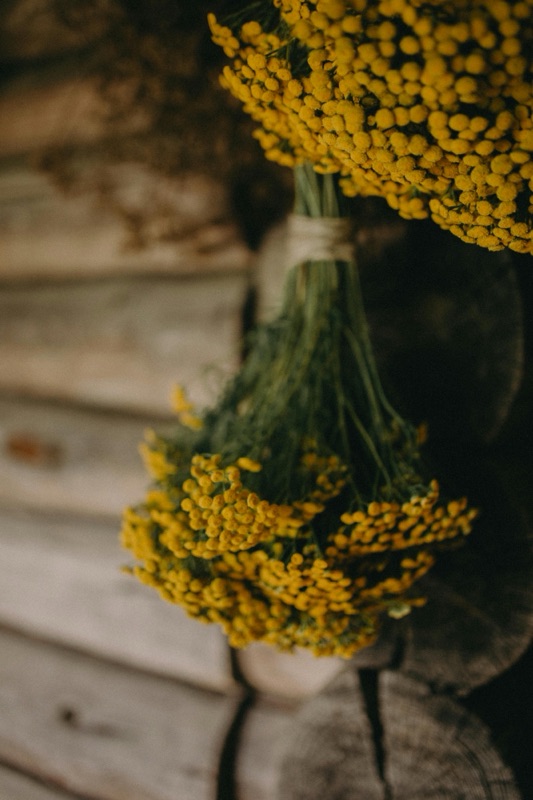
Tansy
by Wanderer MoonChild
🌱 Botanical Basics
- Common Name(s): Tansy
- Folk Name(s): Bitter Buttons, Ginger Plant, Golden Buttons, Mugwort (confused with), Parsley Fern, Buttons, Bitterwort
- Scientific/Latin Name: Tanacetum vulgare
- Family: Asteraceae (Daisy family)
- Plant Type: Hardy perennial herb
- Botanical Description: Upright clumping herb 2–4 feet tall with feathery, fern-like, aromatic leaves; flat-topped clusters of small, button-like yellow flowers with no petals; strong, bitter scent.
- Growing Zones/Climate: USDA zones 4–8; hardy in temperate climates.
- Best Zones for Growth: Thrives in cooler, northern temperate zones.
- Habitat & Range: Native to Europe and Asia; naturalized in North America. Found along roadsides, meadows, and riverbanks.
🌿 Cultivation & Harvest
- Soil & Sun Requirements: Prefers well-drained, sandy or loamy soil; thrives in full sun but tolerates partial shade.
- Propagation: By division of root clumps in spring or autumn; also by seed but spreads aggressively and can become invasive.
- Companion Planting: Repels pests such as ants, flies, moths, and beetles; often planted near roses, fruit trees, and vegetable gardens as a natural insect deterrent.
- Harvesting Guidelines:
- Leaves & Flowers – Harvest midsummer to early autumn when flowers are vibrant.
- Cut aerial parts before seed heads form.
- Drying/Preservation: Hang in bunches or dry flat in a ventilated space. Store in airtight containers away from light.
🌸 Traditional & Historical Use
- Cultural Significance: Used since ancient Greece and medieval Europe for preserving corpses, flavoring food, and as a strewing herb to ward off pests. Associated with Easter feasting in Britain and with funeral rites.
- Traditional Medicine: Used historically as an anti-parasitic (notably against intestinal worms), digestive bitter, and menstrual stimulant.
- Symbolism: Immortality (for its preservative use), protection, endurance.
🌼 Medicinal & Practical Properties
- Active Constituents: Thujone (toxic in high amounts), camphor, borneol, tannins, flavonoids, volatile oils.
- Medicinal Uses (historical/traditional):
- Vermifuge (worm expelling)
- Digestive aid and bitter tonic
- Menstrual regulation (emmenagogue)
- Externally for bruises, sprains, scabies, lice
- Preparation Methods:
- Infusions and tinctures (low doses, historically used)
- Poultices or compresses externally
- Essential oil (extremely potent; external use only and diluted)
- Dosage & Guidelines:
- Internal use is strongly cautioned—modern herbalists rarely recommend due to toxicity of thujone. Historically, very small amounts (few drops tincture or teaspoon of dried herb) were used.
- Safety/Precautions:
- Toxic if taken in excess—may cause convulsions, liver damage, and even death.
- Avoid in pregnancy, lactation, or with seizure disorders.
- Not for regular internal use in modern herbal practice.
🌙 Magical & Spiritual Properties
- Elemental Association: Venus/Water (sometimes linked to Mars for protective energy)
- Planetary/Deity Correspondence: Venus, Hecate, associated with spirits of the dead due to funerary use.
- Magical Correspondences: Protection, longevity, spirit communication, warding off illness and evil.
- Ritual Use: Burned as incense for purification; carried in sachets for protection; used in funerary rites and ancestor work.
- Symbolism in Divination/Dreams: May represent resilience, endurance, or warnings of excess/toxicity.
🌍 Ecological & Culinary Uses
- Pollinator Value: Flowers attract bees, hoverflies, and beneficial insects.
- Wildlife Uses: Bitter oils deter most grazing animals, though insects may use as host plant.
- Culinary Uses: Historically used to flavor puddings, cakes, and omelets (Easter traditions), but no longer recommended due to toxicity.
- Household/Practical Uses:
- Used as a strewing herb to deter insects in households.
- Placed in coffins for preservation.
- Infused in vinegar for cleaning or pest control.
⚡ Fast Facts
- Quick Uses: Protection herb, insect repellent, ancestor ritual herb.
- Notable Traits: Strongly aromatic, insect-repelling, preservative qualities.
- Special Notes: Once highly valued in Europe but now considered invasive in parts of North America. Internal medicinal use is discouraged today.
📖 Supporting Notes
- Grieve, M. A Modern Herbal.
- Chevallier, Andrew. Encyclopedia of Herbal Medicine.
- Foster, Steven & Duke, James. Peterson Field Guide to Medicinal Plants.
